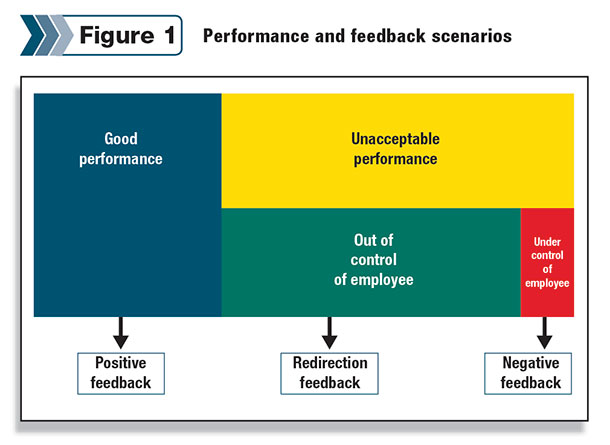- “He (or she) needs to work faster.”
- “My employees make too many mistakes.”
- “She (or he) completes a task and then slacks off.”
I often respond with the following question: “Is your employee intentionally performing below your expectations?” The answer to this question is almost always an unequivocal “no.”
A “yes” answer would be harder to deal with because major changes would be required in both the employee’s attitudes and his or her work performance.
The “no” brings both good news and bad news. The good news is that the problem – inadequate performance – is usually correctable.
The bad news is that our traditional way of thinking about poor employee performance is usually inadequate to correct the problem.
The purpose of this article is to articulate an approach that greatly increases the likelihood of employee performance improvement.
Our traditional way of thinking is that there are two kinds of feedback: positive and negative. In the above situation, positive feedback is inappropriate for the employee’s performance, as the performance is below expectations.
Negative feedback is usually thought of as a reprimand. Put yourself in the shoes of the employee in this situation. You are not intentionally doing anything wrong; however, you are not meeting expectations.
Something is occurring you at least perceive to be out of your control that is keeping you from meeting expectations. In this situation, the employee will likely view the negative feedback – the reprimand – as unfair.
I truly believe that most supervisors recognize that neither positive nor negative feedback is appropriate. They do not, however, realize there is a third option.
Look at Figure 1. The performance situation we are discussing is represented by the green rectangle. We now introduce a third type of feedback: redirection.
The answer to our challenge of providing the information our employee needs to improve is to use redirection feedback. However, redirection feedback, although incredibly powerful, is challenging to deliver.
The first challenge for most supervisors is a tendency to blame employees for their performance problems instead of analyzing the poor performance to determine the real cause of the problem.
This tendency to blame is almost instinctive. As long as we have that attitude, it will be difficult to deliver high-quality redirection feedback.
Let’s look at a football example to understand the second challenge. Peyton Manning is one of the greatest quarterbacks in professional football.
He is also a student of the game and works tirelessly to improve his performance. Now, put yourself in Peyton’s shoes. You are watching game film and see something you did wrong, or the coach suggests an improvement.
Let me suggest that Peyton will have two very different emotional reactions:
- His first emotion will be negative: disappointment, even frustration. Not a one of us wants to hear about what we did wrong.
- After some time and thought, his second emotion will replace the disappointment. He now recognizes an opportunity to do better – to improve. He may even feel excitement at the opportunity to improve.
The second challenge is that the initial reaction of the employee, like Peyton Manning, will almost always be negative. We, as human beings, do not want to hear about problems, but we want to know about them so we can improve.

The danger in providing feedback in this situation (the green rectangle in Figure 1) is that the employee will perceive he or she is being blamed or that the feedback is unfair.
The defensiveness and anger will then often keep the employee from replacing the disappointment with interest in or excitement about the potential improvement.
The following four steps can be used to maximize the likelihood that your feedback will be perceived as redirection and the employee will focus on improvement:
1. Identify the failure to meet performance (or behavior) expectations. Answer the question: What was the expected performance and how is the actual performance short of that expectation?
Previously established, clear performance expectations make this step and those that follow much easier.
2. Analyze the failure to meet expectations to understand the real or root cause. You may be able to come to a definite conclusion or you may only gain insights in preparation for the discussion with the employee.
You must be objective. It is easy to blame the employee for the inadequate performance; however, most performance failures are the result of a management failure.
Ask: What have I done that has contributed to this problem? It could be lack of training, lack of encouragement and support, insufficient clarity of expectations, etc.
Based on this analysis, there are two circumstances where you decide performance was acceptable:
- You conclude that the root cause of the failure to meet the expectation was that the expectation was set too high and the employee’s performance was in fact satisfactory.
In this case, you meet with the employee to inform him or her of your conclusion, reset the expectations and provide encouragement for meeting the re-set expectation. - You conclude there were unexpected circumstances – weather, unexpected changes impacting this performance measure, etc. – that caused the failure to meet expectations and the employee’s performance was satisfactory.
In this case, you meet with the employee to inform him or her of your conclusion, reemphasize the expectations, and provide encouragement to meet the expectations.
3. Unless you decided in step 2 that performance was acceptable, you now need to plan for a redirection discussion with the employee.
This will likely not be an easy discussion. Your attitude and body language is very important. You must approach the discussion as a coach and a teacher.
We know from above that it is likely the employee will be disappointed. By being open, positive, encouraging and non-accusatory, your goal is to keep him or her from becoming defensive, frustrated or angry.
You need to share your insights about the real problem, seek the employee’s input and ideas, and listen carefully.
4. Conclude the meeting by specifying a plan to correct the real cause, by establishing a new and attainable performance expectation, and by expressing confidence that the expectation can be met.
A concluding point: Providing redirection feedback is not easy. The huge positive is that with great redirection feedback plus positive feedback and encouragement, the need for negative feedback can be dramatically reduced and even eliminated. ![]()
Bob Milligan is also professor emeritus, Dyson School of Applied Economics and Management, Cornell University.

Bob Milligan
Senior Consultant
Dairy Strategies LLC








